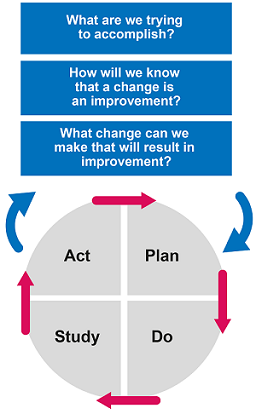8 Processes for improvement
Now that you are aware of both AMS interventions and methods to monitor their success, your facility needs to develop a process to identify and apply those with most potential for success in your situation, and to evaluate their efficacy.
The Institute for Healthcare Improvement’s Plan–Do–Study–Act (PDSA) cycle can be useful for setting goals and measures of success. It is important to choose the AMS strategy best suited to the resources and situation at your healthcare facility.
Activity 8: The Plan–Do–Study–Act (PDSA) cycle
Look at the Plan–Do–Study–Act (PDSA) cycle [Tip: hold Ctrl and click a link to open it in a new tab. (Hide tip)] and add your own ideas to the model for improvement in Figure 11.
Discussion
At this stage your thoughts might be quite general, because it is necessary to form a team that brings together expertise from your hospital to identify a plan that will suit your situation. You might have thought of the following:
- Setting aims: To reduce the use of Reserve and Watch group antimicrobials in your hospital; to improve understanding of the situation in your facility by establishing surveillance for AMR and AMU.
- Establishing measures: You will need to assess the current use of antimicrobials in order to formulate a specific time-limited goal. PPS is one method to do this.
- Selecting changes: Consider the appropriate strategy. You might wish to talk to your colleagues in other hospitals, who may have some experience of these processes. You may have suggested introducing prospective audit and feedback, or working on involving different hospital staff and providing education on AMR to begin to build a positive culture to address it. You may also have considered revisiting the principles of diagnostic stewardship and investing in your laboratory facilities to support AMS.
7.2 Quality measures: AMU and point prevalence surveys




